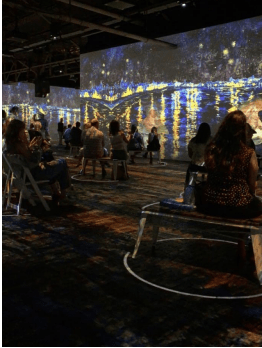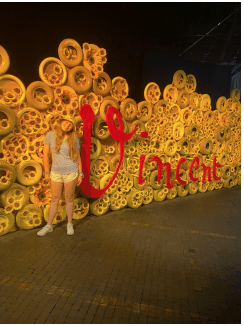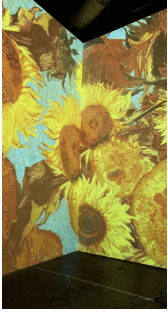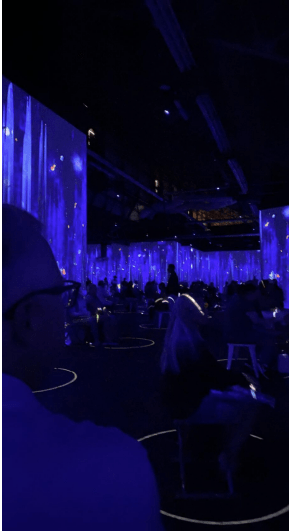ART MARKETS FINAL PROJECT
By: Catharine Yoder
 The Immersive Van Gogh Experience is a visual explosion of “super-trippy” digital projections of Vincent van Gogh’s imagery onto the walls and floors of an exhibition space and turns it into a kind of Van Gogh dream world. There are nearly 50 Immersive Van Gogh Experiences across the U.S. and Europe. The immersive experiences were made popular first in Europe over a decade ago but have recently gained global traction after being featured in Netflix’s Emily in Paris.
The Immersive Van Gogh Experience is a visual explosion of “super-trippy” digital projections of Vincent van Gogh’s imagery onto the walls and floors of an exhibition space and turns it into a kind of Van Gogh dream world. There are nearly 50 Immersive Van Gogh Experiences across the U.S. and Europe. The immersive experiences were made popular first in Europe over a decade ago but have recently gained global traction after being featured in Netflix’s Emily in Paris.
Immersive Van Gogh promises an hour-long experience completely transporting visitors into Vincent Van Gogh’s greatest works, accompanied by experimental electronic music with ethereal piano. Here, the entirety of the space pulses with moving imagery; a light-and-video rendering of Van Gogh’s thick paint strokes, his fuzzy distant stars and hopeful sunflowers as a kind of living wallpaper. The projections move, the images shifting from dark to light, the colors explode all around you. The scale, the images, and the effect of being inside Van Gogh’s work have led some visitors to cry. Sounds of nature (cicadas buzzing, water ripples) and backing songs by the voices of Edith Piaf to Radiohead gives it a certain emotional atmosphere. Groups and families often sit in circles on the ground, socially distanced, to soak in the sights and the soundtrack.

When arriving at the exhibit in Charlotte, NC, I was shocked at the location choice. The exhibition was inside of a huge empty warehouse, located inthe Camp North End event venue of suburban Charlotte. My expectations were exceeded as soon as we got out of the car. Walking into the main entrance to the venue, there were dozens and dozens of bright yellow sunflowers which was the staple logo of the exhibition. The friendly staff gave everyone a free goodie bag with two Van Gogh posters and a beautiful sunflower inside as well as a mat that you would use to sit on while you were in the exhibit. We were directed into the main pavilion inside the warehouse where they had a gift shop and an eating area for when you come out of the exhibition. I liked that there were a lot of photo-op worthy sculptures of large mixed-media sunflowers and one large sculpture outside of the exhibition room which was made up of yellow spray painted tires and fake sunflowers with Van Gogh’s signature in front of it.
 When it was our turn to go into the exhibit, we were escorted into the large exhibition room and immediately met with an explosion of moving bright colors, painted trees and flowers, and a beautifully somber piano ballad playing over the speakers. I was overwhelmed by the size of the room where the only source of light was the masterpieces being projected on the walls and floors. We eventually found a place to sit in a secluded corner and watched the magic happen in front of us. Images of Van Gogh’s irises and cherry blossom trees transitioned across the walls and floors. Beautiful pictures of sunflowers bloomed from the ground and surrounded the connected walls. The serotonin was really hitting me from just watching the paintings come to life on the walls and I was honestly starstruck. I felt like I was actually in the painting.
When it was our turn to go into the exhibit, we were escorted into the large exhibition room and immediately met with an explosion of moving bright colors, painted trees and flowers, and a beautifully somber piano ballad playing over the speakers. I was overwhelmed by the size of the room where the only source of light was the masterpieces being projected on the walls and floors. We eventually found a place to sit in a secluded corner and watched the magic happen in front of us. Images of Van Gogh’s irises and cherry blossom trees transitioned across the walls and floors. Beautiful pictures of sunflowers bloomed from the ground and surrounded the connected walls. The serotonin was really hitting me from just watching the paintings come to life on the walls and I was honestly starstruck. I felt like I was actually in the painting.

While this was an immersive experience and not your typical art museum, art market, or gallery, I technically connecteditto being a museum. Museums have the power to support artists by creating a more public understanding of art and artists. In the case of the Immersive Van Gogh Experience, their goal was to honor the great works of the infamous artist and preserve his legacy through a new way of viewing his artwork digitally to involve the audience and leave a lasting impact. The growth of immersive digital art museums have attracted audiences that are searching for a new way to experience art museums. Overall, my visit to the Immersive Van Gogh Exhibit has taught me more about how the digital art museum community grows in popularity by involving their audiences with the works of art while also preserving the legacies of famous artists to profit just like regular art museums do.